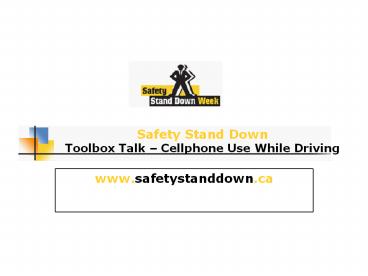Safety Stand Down Toolbox Talk - PowerPoint PPT Presentation
1 / 12
Title:
Safety Stand Down Toolbox Talk
Description:
... (Psychology Professor David Strayer ... Research also found that the tunnel vision caused by cellphone use continued well after ... Document presentation format: – PowerPoint PPT presentation
Number of Views:320
Avg rating:3.0/5.0
Title: Safety Stand Down Toolbox Talk
1
Safety Stand Down Toolbox Talk Cellphone Use
While Driving
- www.safetystanddown.ca
www.safetystanddown.ca
2
Safety Stand Down
- Introduction
- There is an urgent need for workplace safety. The
ripple effect of injuries is devastating to
family, co-workers, and the company. - Why discuss the hazards of cellphone use while
driving? Driving remains the leading cause of
death in our industry and in vehicle distractions
are multiple. Cellphone use while driving is one
of the many distractions and is very dangerous.
Its mentally demanding, drivers reaction time
to hazards is very poor, and it reduces the
drivers field of view.
3
Safety Stand Down
- Why are cellphones mentally demanding? Why do
they increase drivers reaction time to hazards
and why do they reduce the drivers field of
view? - There are four types of driving distraction
- VISUAL Looking for the cellphone.
- BIOMECHANICAL Manipulating a device, such as
dialing a phone number, or for those users of
PDAs, formulating an email response.
4
Safety Stand Down
- AUDITORY Being startled by a ringing cellphone.
- COGNITIVE Mind not on the task, thinking about
something other than driving. - HANDS FREE cellphones reduce VISUAL and
BIOMECHANICAL distractions however, they do
nothing for the other two. More importantly, they
do nothing for the COGNITIVE distraction. This
being the most important task concentrating on
driving.
5
Safety Stand Down
- Why cellphone conversations are mentally
demanding - Cellphone users visualize or create in their
minds an image of the person being spoken to.
This takes mental effort and undermines the
cognitive work of interpreting the driving
environment. - When you are engaged in a cellphone conversation,
you have to listen to the other person, think
about what they are saying, and plan your
response. This takes away some resources which
you would otherwise have applied towards driving.
6
Safety Stand Down
- Cellphone drivers are trapped by social etiquette
that will not let them drop, discontinue, or be
unresponsive in cellphone conversations. - Social conventions and habits govern expectations
of how long we pause, how we respond, vocal tones
and inflections, appropriate placement and
expression of nonverbal cues (uh huh, um, oh,
etc.), and levels of interest and engagement
expressed. - Stressful, emotional or important conversations
are even more demanding, but even the mundane
conversations will remove your concentration from
the task of driving.
7
Safety Stand Down
- Why cellphones increase drivers reaction time to
hazards - Studies have shown that drivers engaged in
cellphone conversations - Are four times more likely to crash than other
drivers. - Pose a risk comparable to alcohol impaired
driving at 0.1 BAC Thats above the legal limit
of Canada of 0.8. - Significantly have poorer driving performance
whether measured by speed control, following
distance or reaction time. - A major study has been performed by University of
Utah (Psychology Professor David Strayer 2001).
8
Safety Stand Down
- Results
- Reaction time while driving and using a cellphone
is worse than the reaction time when driving
under the influence. (Of course, neither is
acceptable practice. The difference is that only
one is currently against the law). - The driver using a cellphone has travelled 14m
longer than a driver with normal reaction. - Drivers take longer to react to the traffic
signals. They are twice as likely to miss a
traffic signal when they are talking on the
cellphone. - Although hands free telephones reduce manual and
visual distractions, cognitive distractions are
still present.
9
Safety Stand Down
- Why cellphone use while driving reduces your
field of view - Eye-movement of drivers using cellphones is
reduced to tunnel vision because they are
concentrating on the conversation. - Research also found that the tunnel vision caused
by cellphone use continued well after the
conversation ends. Perhaps because the driver is
still thinking about the conversation. - The study found that most drivers seldom glance
away from the road when talking on the cellphone.
You should move your eyes every two seconds to
avoid tunnel vision.
10
Safety Stand Down
- Responsibilities as a driver
- Never take a phone call while driving.
- Allow passenger or voice mail box to take the
message. - In an emergency, pull well off the road to
receive or send phone calls.
11
Safety Stand Down
- Responsibilities as a caller
- Ask if they are driving
- End the conversation if you suspect they are
driving
12
Safety Stand Down
- Conclusion
- What can I do to help?
- Make the decision to stop and tell others as
well. It starts with you as an individual and you
need to modify your behaviour. Like any other
habit, it will take time to change. - Youll survive a missed phone call, but you
might not survive a collision. Transport
Canada































